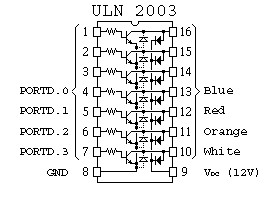
Fig. 2 - Hardware Schematic
Hardware Design
The hardware for the Non-Orthogonal Plotter consisted of a 16-key keypad, 16x2 LCD panel, a couple of 12V 7.5 degree unipolar stepper motors, a 12V solenoid, springs and fishing line, and the pen apparatus.
The keypad is wired to PORTB on the microcontroller, and the LCD to PORTC. The two stepper motors are controlled through PORTA, and the pen pickup via the solenoid is handled by PORTD. The overall hardware schematic of the device is as follows.

Fig. 2 - Hardware Schematic
Stepper Motor
Each motor was wired to the motor driver (ULN2003) chips as follows. The ULN2003 chips were wired to PORTA (PIN0-3 for the right motor and PIN4-7 for the left motor) as shown below. The bottom of the axles of the motors were lined with washers to prevent any tangling of the fishing lines in the small gaps that were there.

Fig. 3 - Motor driver pinout
Solenoid
The solenoid was wired to a driver, which consisted of two transistors (TIP31 and Darlington 2N3904), a 1K resistor, and a 12V power supply as shown below. The driver was connected to PIN7 of PORTD.

Fig. 4 - Solenoid driver circuit
Pen Apparatus, Fishing Line, and Spring
The pen apparatus was connected to each motor with fishing line and to the bottom of the board through a rubber band which was connected to a spring. This is shown below:

Fig.5 - Drawing Board Setup
The pen apparatus was made with a cardboard spool. The bottom of the spool was attached to a circular piece of cardboard. The bottom of this was evenly lined with weights to prevent the apparatus from tipping and glued to a ring of ball bearings to allow smooth movements across the sheet. The pen was attached to a solenoid and placed through the center of the spool. We placed a small spring inside the solenoid for pressure during writing.
The starting position of the pen apparatus is towards the bottom of the board, with both fishing lines completely unwound. We encountered several challenges in building this. One of the biggest challenges was to generate enough tension on the spring side of the board to allow the system to work horizontally. We tried various solutions using different spring lengths, multiple springs, only rubber bands, and even tilting the board. The best solution was found in the combination of the spring and rubber band. We also had trouble with the pen apparatus and initially tried spray-can lids and plastic containers. We eventually discovered the spool to be the best solution and managed to find one with perfect inner and outer radii. The pen apparatus was too light in the beginning and was very easily tilted over. To prevent this, we added weights the bottom of the apparatus to make it heavier.